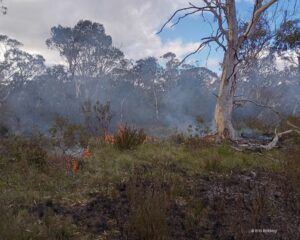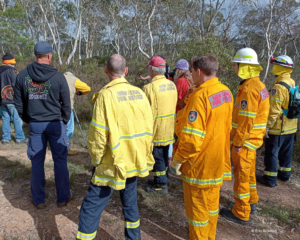
Supported by the Upper Shoalhaven Landcare Local Landcare Coordinator (LLC), Erin Brinkley, this project was born from the Black Summer Bushfires which burnt over 250,000ha in the Upper Shoalhaven Landcare region. The fires caused significant biodiversity loss, removal of critical habitat, extreme soil erosion and reduced water quality. In addition, there was a major physical, mental and emotional toll on the community, with people fighting the blaze on all sides and businesses crippled by necessary road closures during the prolonged hazardous conditions.
The ‘Healing Country & Community with Good Fire Practices’ project aimed to deliver an educational experience that increased local knowledge and leadership in fire management practices specific to the region with over 80 participants taking part in the workshops.
With funding from the NSW Government’s Increasing Resilience to Climate Change Community Grants Program, Upper Shoalhaven Landcare ran a series of cultural engagement workshops in Broad Gully, Mongarlowe.
Under the guiding eye of an Aboriginal woman, their first workshop focused on training local Rural Fire Service (RFS) in flora identification, surveying methods, and understanding the best times to burn based on species’ cycles.
The second workshop was a two-day practical demonstration of cultural burning in action. The demonstration involved members of Landcare, Mongarlowe Volunteer Rural Fire Brigade, and local landholders who saw cultural burning in action with 10ha burnt and had the opportunity to listen and learn from a team of Walbunja Fire Practitioners.
 By bringing together local RFS brigades, botanists, landholders, Landcare and Aboriginal groups, Upper Shoalhaven facilitated vital knowledge sharing and demonstrated how good fire practices can be used as a tool to reduce fuel loads and help mitigate the impacts of our changing climate. The workshops proved burning can be conducted in a peaceful and relaxed atmosphere and improved community confidence in using fire as a tool, at the right time, to manage the land and reduce bushfire risk more broadly.
By bringing together local RFS brigades, botanists, landholders, Landcare and Aboriginal groups, Upper Shoalhaven facilitated vital knowledge sharing and demonstrated how good fire practices can be used as a tool to reduce fuel loads and help mitigate the impacts of our changing climate. The workshops proved burning can be conducted in a peaceful and relaxed atmosphere and improved community confidence in using fire as a tool, at the right time, to manage the land and reduce bushfire risk more broadly.
In addition, participants learnt that by adopting these cool burning techniques they can improve landscape health and reap huge biodiversity benefits in the process. Growing in understanding that cool-burning enhances the natural environment, but is also extremely beneficial for the community, giving people a chance to come together and do something positive post-bushfires.
A healthy landscape lends itself to a healthy community, and the locals involved in the project came away with a positive sense that, together, we can help address the impacts of climate change and extreme bushfires in our region.
This initiative is made possible by the NSW Landcare Program. A collaboration between Landcare NSW and Local Land Services, supported by the NSW Government.